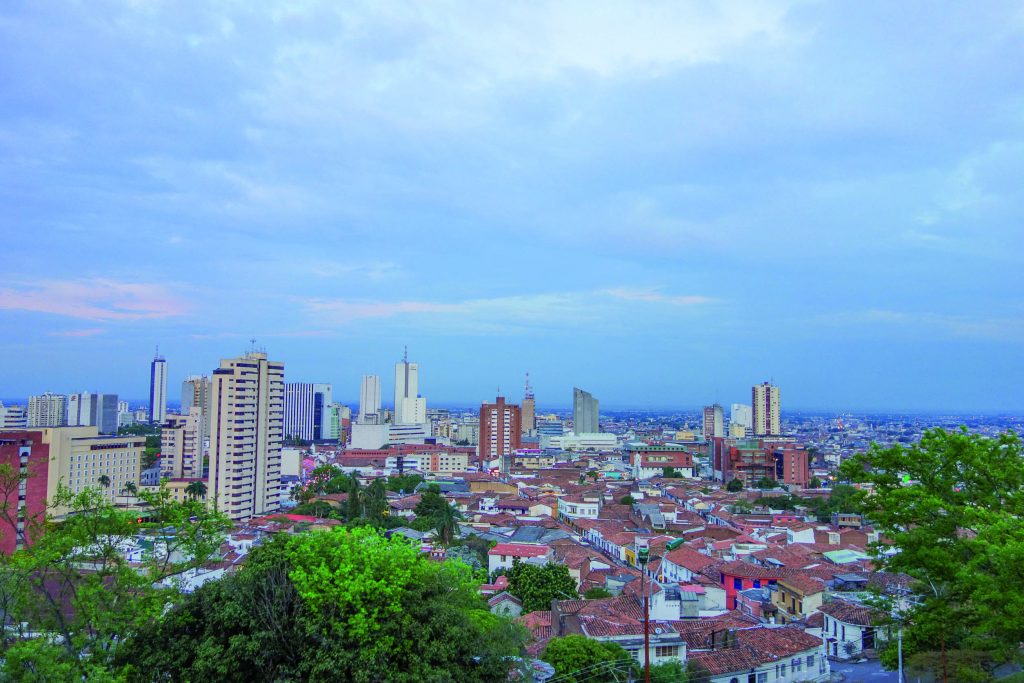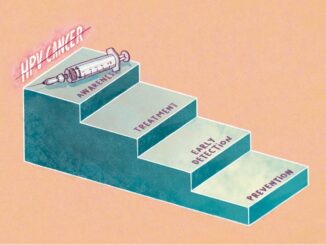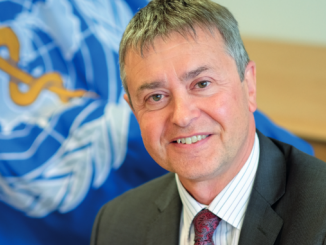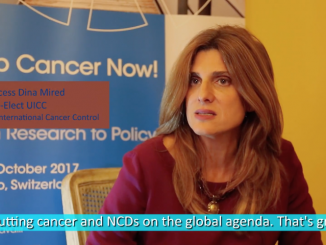When it comes to developing capacity for tackling cancer, all too often the best intentions founder because key players are not engaged, costings are not done, sustainable funding is not secured, visiting experts dispense their wisdom and fly off home. Peter McIntyre reports on a new initiative designed with those pitfalls in mind.
Four cities with a combined population of more than 12 million people are pioneering a global campaign to build sustainable cancer services in low- and middle-income countries.
The City Cancer Challenge was launched in January 2017 by the Union for International Cancer Control (UICC) and is supported by 40 partners including the World Bank, the World Economic Forum and the Access Accelerated consortium of pharmaceutical companies targeting non-communicable diseases.
The aim is to galvanise a global network of cities with more than a million inhabitants to focus on the quality and coverage of cancer care, identify and fill in gaps and reduce mortality.

A total of five ‘key learning cities’ will lead the way. The first four are Cali in Colombia (pictured above, population 2.4 million); Greater Asunción Metropolitan Area, Paraguay (2.2 million); Yangon, Myanmar (5.2 million); and Kumasi, Ghana (2.6 million).
They have embarked on a three-year programme to develop, cost and implement a plan to tackle cancer as a priority health issue, in a context of the Sustainable Development Goal global commitment to reduce premature deaths from non-communicable diseases (NCDs) by one-third by 2030. Cities will receive support from UICC and international partners.
As the programme rolls out, they will be joined by cities with a population greater than one million that are committed to improving access to quality cancer care for their citizens, and meet the requirements and opt to become a ‘C/Can 2025 Challenge City’. The fifth ‘key learning city’ will be announced during 2018, along with up to five challenge cities.
The central thrust is to bring public, private and civil society stakeholders from the cities together with regional and national governmental bodies, to identify gaps and set priorities for cancer detection, treatment and care. The city authorities and the national governments must sign commitments to back the project, with particular emphasis on determining sustainable financing solutions to ensure ongoing delivery of cancer treatment services. Progress in developing services and reducing cancer mortality will be monitored, but there will be no single service model. Each city will set its own course.
Each city establishes an executive committee and a series of technical groups to identify gaps and priorities in areas of cancer diagnosis, treatment and care, with support from a C/Can 2025 city manager and consultant technical experts. As well as local and national government bodies, the multisectoral model brings together cancer societies and networks, patient support groups, professional bodies, private sector bodies and foundations.
Susan Henshall, director of C/Can 2025, says that it is important that city executive committees bring together leaders in the city, region and government “who are able to take decisions and drive the process forward”.
“This is a multisectoral group and it is imperative that they work as a collective. They will tell you openly it is challenging, but when they commit to putting the patients first, a lot of the issues are put aside.”
Melissa Rendler-Garcia, C/Can 2025 director of regional operations, says that it is the growing collaboration and sense of mission that have excited her most about the City Cancer Challenge. “It has been one of the first opportunities for people who work in different institutions to look beyond what they are doing day to day, and envision what an optimal cancer care and control system would look like for their city. Initially it is challenging to begin to use this type of multisectoral approach, but once they start, they really see the value and enjoy the process.”
UICC president Sanchia Aranda recalls that the city challenge grew out of discussions during the 2015 Istanbul World Cancer Leaders’ Summit. “We were lamenting the fact that national cancer control plans tend to sit on the shelves and don’t really mobilise action. They certainly don’t mobilise investment and, because they are government led, they don’t grab the imagination for a range of other players. We identified that governments in low- and middle-income countries tend to have limited capacity to work with the not-for-profit sector, and when they work with the private sector it is often a vested interest relationship, with the private sector wanting to capitalise on rising wealth.”
The C/Can 2025 approach has been modelled in part from the C40 network of cities committed to partnerships to address climate change, with the added understanding that creating sustainable health programmes requires investment from the national government and buy-in from a wide range of stakeholders.
Sanchia Aranda, who is also CEO of Cancer Council Australia, says, “City investment is a missing piece, but is not enough. You need ongoing commitment to sustainable funding from governments to build sustainable health delivery systems.”
The idea quickly blossomed. “It seemed to engage the imagination of the mayors, the non-profit sector and the private sector. Everyone quite quickly wanted to come to the table.”
Cali and Asunción lead the way
The greatest progress has been made in Latin America. Cali and Asunción have completed needs assessments, and both presented draft implementation plans at the World Cancer Leaders’ Summit in Mexico in November 2017. Both cities are supported by regional and national governments and international networks.
Cali began the C/Can 2025 process in March 2017, selected in part because the Cali Cancer Registry (CCR) is the longest-serving cancer registry in Latin America, having been in continuous operation since 1962. The Cali registry analyses incidence and mortality trends, and has carried out long-term survival analysis for the five leading causes of cancer and for all cases of childhood cancer.
Public awareness in Colombia has been heightened by the fact that President Juan Manuel Santos had surgery for prostate cancer in 2012 and resumed treatment in 2016, and has been very open about his condition. The Valle del Cauca department, of which Cali is the capital, has identified high rates of prostate cancer deaths, high incidence of childhood cancer and an increase in cervical cancer deaths as specific challenges for cancer control.
“The initiative helps demonstrate that investing in access to timely and accurate cancer diagnosis and quality treatment is cost-effective”

Key gaps identified by the C/Can 2025 city executive committee in Cali include: continuing and specialist education for cancer; slow authorisation processes holding up diagnosis and treatment; lack of operational procedures, treatment protocols, guidelines, and quality assurance programmes; gaps in access to essential oncology medicines; lack of radiotherapy equipment; and weaknesses in pathology.
Cali is receiving support from the American Society for Clinical Pathology (ASCP) to implement improvements in quality control and lab processes. One of the ASCP volunteer experts is herself originally from Cali. Rendler-Garcia says: “For her it was very exciting to be able to go back to her own city and work with pathologists, some of whom she knew because she had trained with them.”
In Paraguay, the Ministry of Public Health and Social Welfare recognises cancer as a health priority, and it has adopted a national action plan to prevent and control NCDs. Vaccination against human papillomavirus and hepatitis B have been introduced to the national immunisation programme, and there are programmes to reduce tobacco exposure. Action has been taken to screen women for cervical cancer and for the early detection of breast cancer.
Cancer care is delivered by 18 public and private health care providers across Greater Asunción, and the municipality believes that C/Can 2025 will bring about greater integration and collaboration. Local authorities in Paraguay are working to educate senators in the national Parliament that they need a new law to ensure an effective long-term cancer control programme.
Ivan Allende, Director of Social Services for Asunción Municipality, says, “Civil society organisations need to play a leading role in advocacy actions to position cancer as a top priority in the political agenda. Initiatives like C/Can 2025 can help us to build the case to demonstrate to decision makers that investing in improved access to timely and accurate cancer diagnosis and quality treatment is cost-effective.”
Gaps identified by the Asunción assessment include a need for trained medical professionals, external quality assurance programmes and standard treatment protocols; a need for greater involvement of multidisciplinary teams in treatment decisions; an updated list of essential oncology medicines and easier access to these drugs; limited capacity of radiotherapy services; and low availability and use of opioids for cancer pain management.
“A lot of expats from both Cali and Asunción who have heard about this project from their peers or from their friends, and are in the health profession and want to help, and are already starting with technical assistance,” says Rendler-Garcia. An oncologist from Paraguay now practising in Valencia, Spain, is working with UICC to try to develop long-term fellowships, exchanges and research projects between Paraguay and Spain.
Increasingly there is interaction between the two cities and more broadly across Latin America. The head of planning and evaluation at the National Cancer Institute in Colombia has been helping the team in Paraguay to construct their implementation plan. The President of Uruguay, Tabaré Vázquez, who is a radiation oncologist by training, has agreed to become Ambassador for C/Can 2025 and to co-sponsor a regional meeting in 2018 to focus on costing and budgeting and attract investors.
Financing the action plan
Financing the action plan is identified as a major challenge at the point when a city or country signs a memorandum of understanding.
Rendler-Garcia says, “We explain to the key stakeholders that within the next five years our goal is to assist them in developing a cancer control system and cancer care services at the highest standard possible in their context and sustainable in the long term. They do the costing for the next five-year cycle, but we really want them to go through to 2025 to ensure that the solutions proposed are fully owned by the stakeholders, and that city and national governments are empowered to find mechanisms to sustain financing.
“We are here to lead the process and guide them through it, but they develop the solutions – they are the ones who do the assessment. We will help them with the costing, we will help them find support in certain areas, but for larger budget issues – for capital investments – they are going to have to work with the financing community, with the international and regional banks, and come up with leverage for financing options.”
C/Can 2025 will be launching a ‘City Health Financing Lab’ during 2018 to provide tools, services and networks to help cities cost implementation plans, conduct feasibility studies, and identify and attract new sources of financing.
Director Susan Henshall says, “Our commitment is to support them to deliver a fully costed implementation plan and help cities to identify avenues for financing that plan.”
Yangon and Kumasi
Yangon signed up as a key learning city in July 2017; the Ministry of Health and Sports and Yangon Regional Government signed a memorandum of understanding in October. Findings from the city needs assessment were presented to the city executive committee in January 2018.
In 2014, almost six in ten deaths in Myanmar were attributed to NCDs, with more than one in ten attributable to cancer. Factors in the selection of Yangon as a key learning city were the launch of a National Health Plan in December 2016, aimed at delivering Universal Health Coverage (UHC), and the creation of a Myanmar National Comprehensive Cancer Control Plan (2017–2021).
Kumasi, the second city of Ghana, serves as a hub for cancer care and treatment for the country’s northern and central populations, and has been selected as the first key learning cty in Africa. Breast, cervical, and liver cancer are the most common, but there is a large undiagnosed cancer burden. Late-stage diagnosis and associated challenges for treatment are top priorities. The first official meetings of the C/Can 2025 city executive committee and the international team were scheduled to take place in February 2018.
“Our commitment is to support them to deliver a fully costed implementation plan and help cities to identify avenues for financing that plan”
One of the aims of UICC is to broaden the base of support for the City Cancer Challenge so that it will eventually become a self-supporting initiative, as new cities join and share experiences.
Princess Dina Mired was for 15 years Director-General of the King Hussein Cancer Foundation in Jordan, and takes over from Sanchia Aranda as President of UICC in October 2018. She says that C/Can 2025 offers new hope in tackling the rising tide of cancer in low- and middle-income countries.
“I believe in it very much. When I become President of UICC, I will put all my weight behind it because I have been through the experience of how to implement cancer control in my country, and I have seen all the struggles and trials and tribulations and the resistance.”
She would have welcomed an initiative like C/Can 2025, she says, “… this amazing organisation coming to give you free expert consultancy and then hand-hold for several years until you reach the point where you can do it on your own – how amazing is that?”





